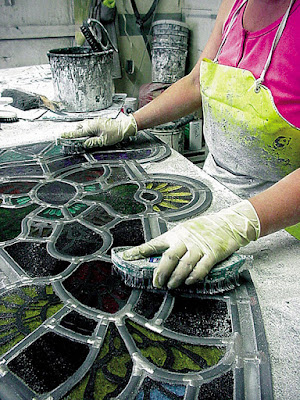The statement that
a sheet of glass can be fused to itself is true in certain circumstances. It applies to transparent and some streaky
glasses best. These forms of glass are more
likely to fuse together successfully although not formulated for fusing.
Transparent and Streaky Glasses
Of course, the best practice is to test for compatibility. I found in my early days of sticking stained
glass together that it was beneficial to test. In doing so, I found Spectrum
and Armstrong transparent and streaky glass to be largely consistent across
many sheets. I did not have access to much
Kokomo or Wissmach. I cannot comment on
how their glass behaves in terms of compatibility across the production range. Not all transparent and streaky glass remains
stable at fusing temperatures. There are
some glasses that opalise, some change colour, some devitrify. This variability makes compatibility testing
important - even for the transparent form of stained glass.
 |
| Photo credit: Lead and Light |
Wispy Glasses
The statement
about fusing to itself is less applicable to wispy glass. Not all the wispy stained glass from the same
sheet can be fused. It seems to be
dependent on the amount of opalescence in any one area of the glass. I found that it is possible - if you are very
careful - to fuse certain Spectrum wispies with the clear fusing standard on
top, but not on the bottom. This should
be applicable to other manufacturers’ wispy glass too. There must be a marginal compatibility that
is contained by the clear fusing glass on top, but I am not certain.
 |
| Photo credit: Lead and Light |
Opalescent Glasses
The statement about
fusing to itself is almost completely inapplicable to opalescent glass. Stained glass opalescent glass does not have
the compatibility requirements of fusing glasses. They very often severely devitrify when taken
to fusing temperatures. This
devitrification means that opalescent stained glass is often not compatible
with itself. So, no amount of twiddling
with schedules will make stained glass opalescent glass fusible, even with
itself.
Manufacturers have
spent a lot of time and effort to produce fusing compatible opalescent glass. It is as though there is a minor element of
devitrification embodied in the opalising process. Whether this is so, it becomes very apparent on
doing compatibility testing that opalescent stained glass has severe devitrification
at fusing temperatures.
 |
| Stock photo |
Compatibility Testing
It is important to
test for compatibility before committing to the main firing. Some transparent and streaky glass changes
colour, devitrifies, and some opalise at fusing temperatures. This applies with
even more force to wispies. They contain
a significant proportion of opalescence within them. Some opalescents are so unstable at fusing
temperatures that the devitrification becomes so bad the glass crumbles.
The importance of
testing pieces of the sheet for compatibility before committing to a firing is
reinforced by these factors.
Slumping
Slumping temperatures
are not so high as fusing, and it is often stated that single layers can be
slumped. Again, it is not always true.
Some glasses
change colour at slumping temperatures. A few opalise. It is not always certain what effect moderate
temperatures will have on stained glass. The compatibility testing will show. Observe the test firing at slumping
temperatures. Also, you will learn if
there are changes at moderate temperatures.
One element must
be commented upon about slumping. It is
important to have the edges finished to the appearance that you want the final
piece to have. The regularity of the
edges without bumps or divots, and the degree of polish need to be showing
before the firing starts. The slumping temperatures are not high enough to alter the shape or appearance of
the edges.
Firing of stained
glass to itself is normally a low risk activity, but with unpredictable results.
It can teach a lot about behaviour of
glass at higher temperatures. Slumping
single layer pieces can give information about the way single layers of glass
slump or drape. But testing is important
for fusing. And can inform about how the
glass will react at slumping temperatures too.















